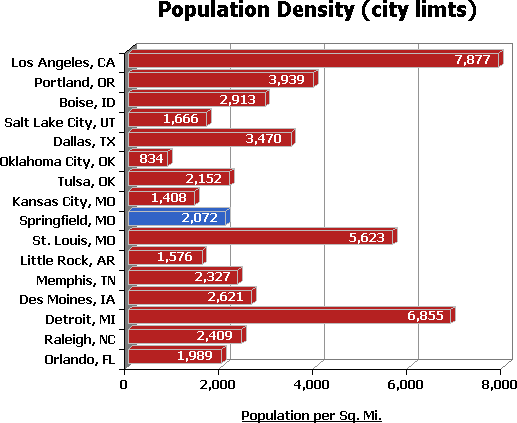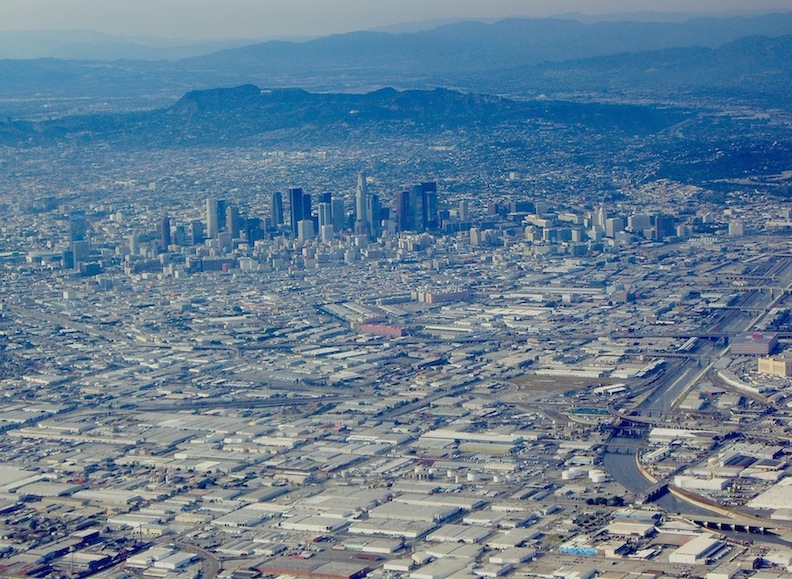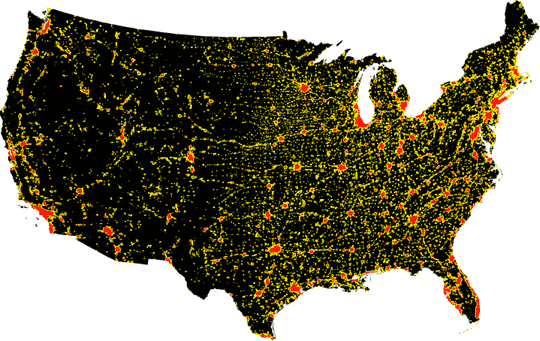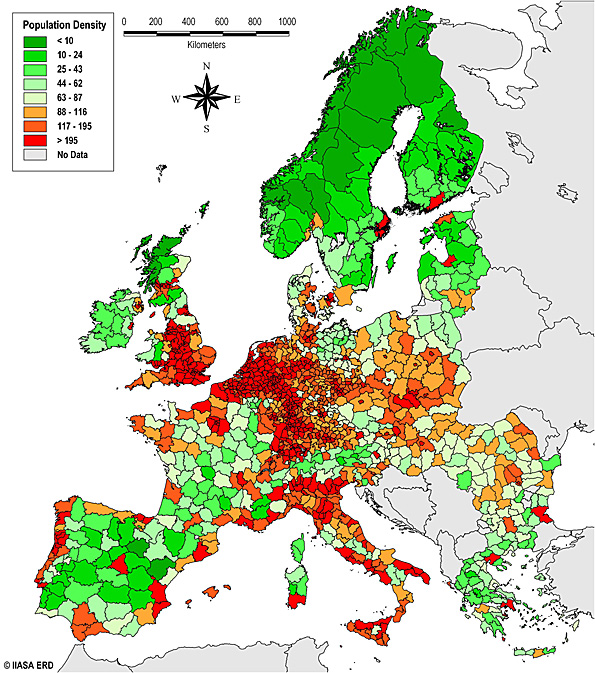Istanbul photographed above ranges from 5,567 and 9,500 to 40,055 people per square kilometer.
Density
Refers to the number of separate items, distinct species, or amount of people in any standard measured area.
With respect to Human population, or the number of persons residing in or occupying an area measured in square miles, square kilometers, hectares, or acres.
The density of the world for example was 54.3 people per square kilometer in 2012, but much of the Earth's terrain is sparsely settled. For some more realistic examples of the number of people per square mile sixteen cities in the United States and over twenty nations are identified and examined below.
Urban comparisons | Bali | Mumbai | Los Angeles | Table | Notes | Density maps.
Urban density is a complicated picture, just consider Atlanta, the capital of Georgia. The city sprawls out over 8,000 square miles. The U.S. census bureau officially measures the area as 8,376 square miles or 21,694 square kilometers.
The immediate urban population is first, the metropolitan statistical area is the second area is the larger region, and then the Combined statistical area is the largest geographical region including much of north Georgia.
• Urban 4,515,419 (9th) Density is 630 people / square mile or 243 people / km2.
• MSA 5,522,942 (9th)
• CSA 6,162,195 (11th)
By nature, the density of any terrain varies depending on climate, proximity to water, and the relief of land affecting the slope of the existing contours of any topography in a particular place. Steeply sloped terrains are less populated than flat regions, though here are exceptions.
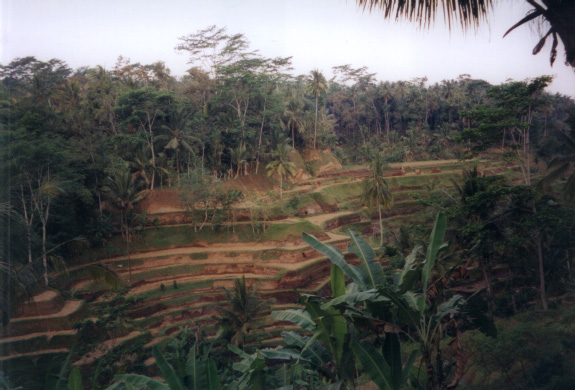
These are examples of terraced rice fields with steep slopes on the island of Bali with a density 673 people per square kilometer.
To convert square miles to square kilometers see this page.
For example ten square miles is a little more than twenty-five square kilometers – 25 km2 (10 m2 = 25.9 km2).
Urban comparisons | Bali | Mumbai | Los Angeles | Table | Notes | Density maps.
Area Measures differ.
The density of entire countries will usually be far less than the density figures for cities. For instance, the density of the vast Unit States for is 34 per square kilometer and India is 416 per square kilometer.
Consider though that San Francisco has a density of 17,179.1 per square mile [or 6,632.8 per square kilometer] and Mumbai ( formerly Bombay, India) is 20,039 inhabitants per square kilometer (51,901.0 / square miles) making Mumbai among the most crowded places in the world.
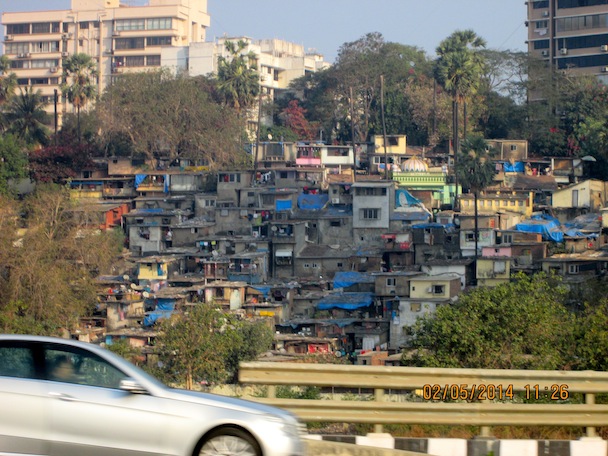
An area of Mumbai near the Arabian Sea.
By comparison to Mumbai's islands, the district of Islington in the Borough of London, U.K. has 13,886 residents per square kilometer.The population density in Los Angeles in the last 2010 census was 7,544.6 people per square mile (2,913 per square kilometer (km²) but 8,092.3 is the 2014 estimated population per square mile, or 3,124.4 people per square kilometer.
The area of Los Angeles city is considered as 468.67 square miles which is 1213.8 km². Use these measures for comparison; to contrast Los Angeles' density with Bangladesh and small islands states see below.
Urban comparisons | Bali | Mumbai | Los Angeles | Table | Notes | Density maps.
Densely populated places around the world:
| Countries reporting the most residents per designated area. | |||
Ranking |
place |
density, 2009-13 |
extent |
| 1 | Monaco | 18,790 | 1.96 square kilometers |
| 2 | Singapore | 7,590 | |
| 3 | Hong Kong * | 6,866 | |
| 4 | Malta | 1,282 | |
| 5 | Bangladesh | 1,188 | |
| 6 | Maldives | 1,128 | |
| 7 | Bahrain | 1,734 | |
| 8 | Gaza / Palestine | 672 | |
| 9 | Barbados | 659 | |
| 10 | Taiwan | 644 | |
| 11 | Korea (South) | 515 | |
| 12 | Netherlands | 497 | |
| 13 | Rwanda | 464 | |
| 14 | Lebanon | 433 | |
| 15 | India | 416 | |
| * | Nauru | 447 | |
Table #1: The comparative density of the world's most crowded nations.
Urban comparisons | Bali | Mumbai | Los Angeles | Table | Notes | Density maps.
World Bank's data for 2012: Population density (people per sq. km. of land area), 2014.
From these ten nations, most of these are island states 6/9 = 2/3 7/10
A "•" before the name indicates an island nation.
These data are derived from World Bank & The Government Information Office of the Republic of China [Taiwan].
Table's data explained.

0. • Macao, China, 19,885 people/ square kilometer is more densely populated than Monaco, less densely populated than Mumbai.
- Monaco is only 1.96 sq. km. or an area is equal to 485 acres.
- • Singapore 7589 people per square kilometer
- * Vatican City 821 / 44 Acres [no World bank data]
- • Malta 1311 people / square kilometer
- Bangladesh 1033.5 people / square kilometer
- • Maldives 1128 people / square kilometer
- • Bahrain 987 people / square kilometer
- • Barbados 649 people / square kilometer
- • Taiwan 646 people / square kilometer [no World bank data]
- • Mauritius 636 people / square kilometer
- Korea (South) 515 people / square kilometer
- Netherlands 497 people / square kilometer
- Rwanda 464 people / square kilometer
- Lebanon 433 people / square kilometer
- India 416 people / square kilometer
- • Puerto Rico 413 people / square kilometer
![]()
#3] Compare • Hong Kong SAR, China: 6,866 people/ square kilometer includes both the island and the New Territories, with the Vatican and the City of London that has a density of 12,331 persons per square mile of an area that is only one square mile.
Infographic - an informative graphic about increasing China's urban density.
#s 4, 6 ,7 & 9 bis; Small Island states pose a problem of measuring:
• Bermuda 1,296 people / square kilometer.
• Maldives 1,128 people / square kilometer,
• St. Maarten ( French sector ) 569 people/ square kilometer, &
• Sint Maarten (the Dutch part ) 1,150 people/ square kilometer, compared to
• Nauru with 446.5 people/ square kilometer with only 9,378 people in a 21-square-kilometer (8.1 sq. mi) area claims to be the world's smallest island nation, but a source of phosphate for fertilizer. Originally named "Pleasant Island," it became part of the Marshall Islands seized by Germany as a colony in 1888. As part of Micronesia an area in the South Pacific between the Philippines and Hawaii consisting of thousands of islands, Nauru is but one of these islands about 26 miles south of the Equator and thus surrounded by a coral reef; the isle has a very narrow strip of arable land 150 meters by 300 meters behind the beach.
Palau, once called the Caroline Islands is among the second largest, small island nations with 21,186 population but in a much larger territory; thus it has a density of 45 people per square kilometer.
Alliance of Small Island States. or AOSIS:
"AOSIS has a membership of 44 States and observers, drawn from all oceans and regions of the world: Africa, Caribbean, Indian Ocean, Mediterranean, Pacific and South China Sea. "
Urban comparisons | Bali | Mumbai | Los Angeles | Table | Notes | Density maps.
Density maps of The United States and of The European Union.
United States density & population distribution map.
